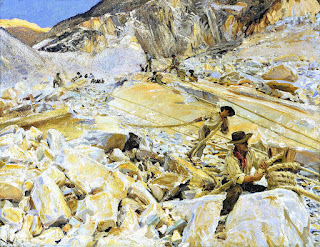Edward Hutton devoted almost 30 pages to recounting the history of Pisa but then turned to a discussion of the holy places in the Campo Santo.
It is but a step across that green meadow to the Baptistery, that like a casket of ivory and silver stands to the west of the Duomo….
Truly, one might as well try to describe the face of one’s angel as these holy places of Pisa, which are catalogued in every guide book ever written. At least I will withhold my hand from desecrating further that which is still so lovely. Only, if you would hear the heavenly choirs before death has his triumph over you, go by night into the Baptistery, having bribed some choir-boy to sing for you, and you shall hear from that marvellous roof a thousand angels singing round the feet of San Rainiero.
Perhaps the loveliest thing here is the great octagonal font of various marbles, in which every Pisan child has been christened since 1157; but it is the pulpit of Niccolo Pisano that everyone praises.
The pulpit which he made for Pisa—perhaps his earliest work—is in the form of a hexagon resting upon nine columns; the central pillar is set on a strange group. A man, a griffin, and animals; three others are poised on the backs of lions, while three are set on simple pediments on the ground; and three again support the steps….
Poor in composition though they be, they are full of marvellous energy, a Roman dignity and weight. It is antiquity flowering again in Christian soil, with a certain new radiance and sweetness about it, a naivete almost ascetic, that was certainly impossible from any Roman hand.
On the far side you may see the Birth of Our Lord, where Mary sits in the midst, enthroned, unmoved, with all the serenity of a goddess, while in another part the angel brings her the message with the gesture of an orator. Consider then, those horses’ heads in the Adoration of the Magi, or the high priest in the Presentation, and then compare them with the rude work of Bonnanus on the south transept of the Duomo; no Pisan, certainly no Tuscan, could have carved them thus in high relief with the very splendour of old Rome in every line. And in the Crucifixion you see Christ really for the first time as a God reigning from the cross; while Madonna, fallen at last, is not the weeping Mary of the Christians, but the mother of the Gracchi who has lost her eldest son. In the Last Judgment it is a splendid God you see among a crowd of men with heads like the busts in a Roman gallery, with all the aloofness and dignity of those weary emperors….Niccolo has in some way discovered classic art, and has been content with that, as the humanists of the Renaissance were to be content with the discovery of ancient literature later: he has imitated the statues and the bas-reliefs of the sarcophagi, as they copied Cicero.
###
Edward Hutton: Florence and Northern Tuscany with Genoa, second edition, London, 1908. Pp. 111-114.










